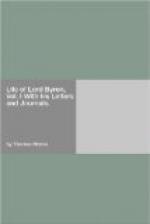The first wife of the father of the poet having died in 1784, he, in the following year, married Miss Catherine Gordon, only child and heiress of George Gordon, Esq. of Gight. In addition to the estate of Gight, which had, however, in former times, been much more extensive, this lady possessed, in ready money, bank shares, &c. no inconsiderable property; and it was known to be solely with a view of relieving himself from his debts, that Mr. Byron paid his addresses to her. A circumstance related, as having taken place before the marriage of this lady, not only shows the extreme quickness and vehemence of her feelings, but, if it be true that she had never at the time seen Captain Byron, is not a little striking. Being at the Edinburgh theatre one night when the character of Isabella was performed by Mrs. Siddons, so affected was she by the powers of this great actress, that, towards the conclusion of the play, she fell into violent fits, and was carried out of the theatre, screaming loudly, “Oh, my Biron, my Biron!”
On the occasion of her marriage there appeared a ballad by some Scotch rhymer, which has been lately reprinted in a collection of the “Ancient Ballads and Songs of the North of Scotland;” and as it bears testimony both to the reputation of the lady for wealth, and that of her husband for rakery and extravagance, it may be worth extracting:—
Miss Gordon of Gight.
O whare are ye gaen, bonny Miss
Gordon?
O whare are ye gaen, sae bonny an’ braw?
Ye’ve married, ye’ve married wi’
Johnny Byron,
To squander the lands o’ Gight awa’.
This youth is a rake, frae England
he’s come;
The Scots dinna ken his extraction ava;
He keeps up his misses, his landlord he duns,
That’s fast drawen’ the lands o’
Gight awa’.
O whare are ye gaen,
&c.
The shooten’ o’ guns,
an’ rattlin’ o’ drums,
The bugle in woods, the pipes i’ the ha’,
The beagles a howlin’, the hounds a growlin’;
These soundings will soon gar Gight gang awa’.
O whare are ye gaen,
&c.
Soon after the marriage, which took place, I believe, at Bath, Mr. Byron and his lady removed to their estate in Scotland; and it was not long before the prognostics of this ballad-maker began to be realised. The extent of that chasm of debt, in which her fortune was to be swallowed up, now opened upon the eyes of the ill-fated heiress. The creditors of Mr. Byron lost no time in pressing their demands; and not only was the whole of her ready money, bank shares, fisheries, &c., sacrificed to satisfy them, but a large sum raised by mortgage on the estate for the same purpose. In the summer of 1786, she and her husband left Scotland, to proceed to France; and in the following year the estate of Gight itself was sold, and the whole of the purchase money applied to the further payment of debts,—with the exception of a small sum vested in trustees for the use of Mrs. Byron, who thus found herself, within the short space of two years, reduced from competence to a pittance of 150_l._ per annum.[10]




